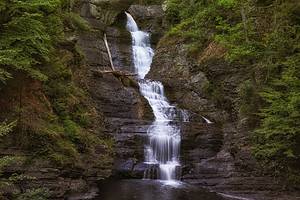Texas isn’t known for its water sources, but the Lone Star State has many rivers, pools, dams, and waterfalls. Many Texan waterfalls are on private property, so it’s not possible to visit them, but others are available for sightseeing and even a quick dip in the cooling water. This article will discover the tallest waterfall in Texas, where it is, and what animals live in and around its cascading falls.
What Is a Waterfall, Exactly?
The name gives it away! A waterfall is a body of water that falls over a ledge into a pool below.
Waterfalls are usually created by erosion. Most natural waterfalls are still in the process of creation as they continue to erode. Waterfalls form when a river or stream flows over hard and soft rocks. Softer rocks erode, but hard rocks stay put. This creates a ledge top that water falls from.
Fast-moving water from the ledge, plus sediments gathered in the flow, crash onto the ground and erode it. This creates a pool. A waterfall’s plunge pool can be a dangerous place because whirlpools emerge from lots of crashing water.
Sometimes erosion from falling water creates an area behind the fall. These caves or “rock shelters” hollow out to vast sizes, but they are always at risk of collapse. When they collapse, the waterfall’s ledge falls into the pool below, and the erosion process continues. Erosion is just one of the ways a waterfall is created. Other ways are earthquakes, glaciers, volcanoes, and landslides.
The Tallest Waterfall in Texas
The tallest waterfall in Texas is Capote Falls, at 175 feet tall. It’s created by Capote Creek plus the Rio Grande rift and Sierra Vieja’s drainage and flows all year round. It seems odd that the tallest waterfall in Texas creates a dramatic oasis in one of the driest areas, but nature is always surprising!
Capote Falls cascades in two stages, which are a 70-foot fall followed by a 105-foot fall. Approximately 300-360 gallons of water tumbles over Capote Falls every minute, but it doesn’t create a Niagara-Falls-type roar. Instead, it trickles and splashes through a delicate mist. The water falls 175 feet into a gravel pool at its base, creating small rainbows before it hits the ground.
Capote Falls is still eroding. Photos from 50 years ago show a large clear pool at its base. In fact, the pool was measured in 1966 and found to be 15 feet deep, but now it’s filled with gravel and stones.
The bad news is visitors can’t enjoy picturesque Capote Falls because it’s on private property.
Where Is Capote Falls Located on a Map?
The majestic waterfall, fed by natural springs, of Capote Falls is situated in the western part of Presidio County. Capote Falls is on the western slope of the Sierra Vieja Mountains and is located west of Marfa, Texas. It is important to note that access to Capote Falls is restricted as it is located on private property, and a locked gate prevents further entry shortly after departing FM 170.
Wildlife Around Capote Falls
Capote Falls is located in one of the driest West Texan spots, so it’ll be no surprise that it attracts a wide variety of common and rare animals. The fact that Capote Falls is situated on private land allows wildlife to live without human interruption.
Wildlife around Capote Falls includes the following animals.
- Cliff swallows: hundreds nest on cliff walls near the waterfall and close to the cave.
- Canyon wrens: whose songs echo in the cave behind the falls.
- Black vultures: a rarity in Texas, black vultures have been spotted near the waterfall.
- Mastiff bats: rare bats whose faces resemble mastiff dogs!
- Mountain lions: elusive mountain lions drink and hunt around the falls.
- Bobcats: rarely seen, but both species of Texas bobcat use the Capote Falls for water and prey resources.
- Mule deer: Canyon Creek and Capote Falls are essential water sources for mule deer.
- Porcupines: slow-moving porcupines amble along the creek to the falls to eat the greenery the water sprouts there.
- Whiptail lizards: all female lizards that reproduce via parthenogenesis.
- Whipsnake: potentially a Capote Canyon sub-species of scientific interest lives here.
Capote Falls is a hugely important resource to wildlife because it’s a rare water-drenched spot in an inhospitable dry environment. All animals need water to survive, and Capote Falls provides it for numerous species.
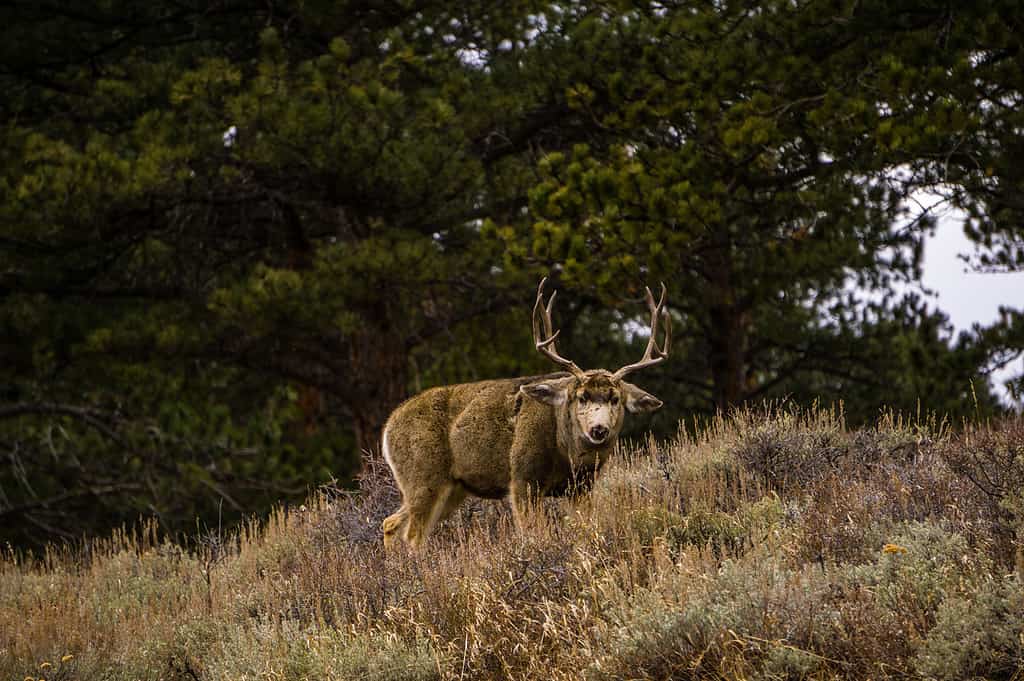
Mule deer is a common species around Capote Fall.
©iStock.com/Sparty1711
Plants Around Capote Falls
One of the most exciting plants around Capote Falls is the endemic Hinckley columbine, which is a type of aquilegia chrysantha. Its fern-like foliage reaches 3.5 feet tall, and bright yellow flowers attract pollinators. It only grows in the wild here, so this is a particular spot.
Around the rocks and in the Capote Falls cave, sun-shy maidenhair ferns line up, avoiding the heat but drinking in humidity created by the Texan sun evaporating Capote Falls cascading water.
There are also foxtails, cottonwoods, ash, hackberry, goldenrod, and willows, all of which are water lovers and not found in the desert stretches of Texas. A few feet from the falls, back into the harsh sun, are typical Texan desert plants such as lotebush, prickly pear, grama grass, and mesquite.
The Second Tallest Waterfall in Texas
The second tallest waterfall in Texas is beautiful Madrid Falls. It’s 100 feet tall and cascades into a large clear pool.
Visitors are welcome, although the journey is hard going. A four-wheel drive vehicle is recommended if you’re not up for hours of hiking. Madrid Falls is located in Big Bend Ranch State Park in the Chihuahuan Desert. It’s very close to the third tallest waterfall in Texas, Mexicano Falls! Mexicano Falls is 80 feet tall and just as beautiful.
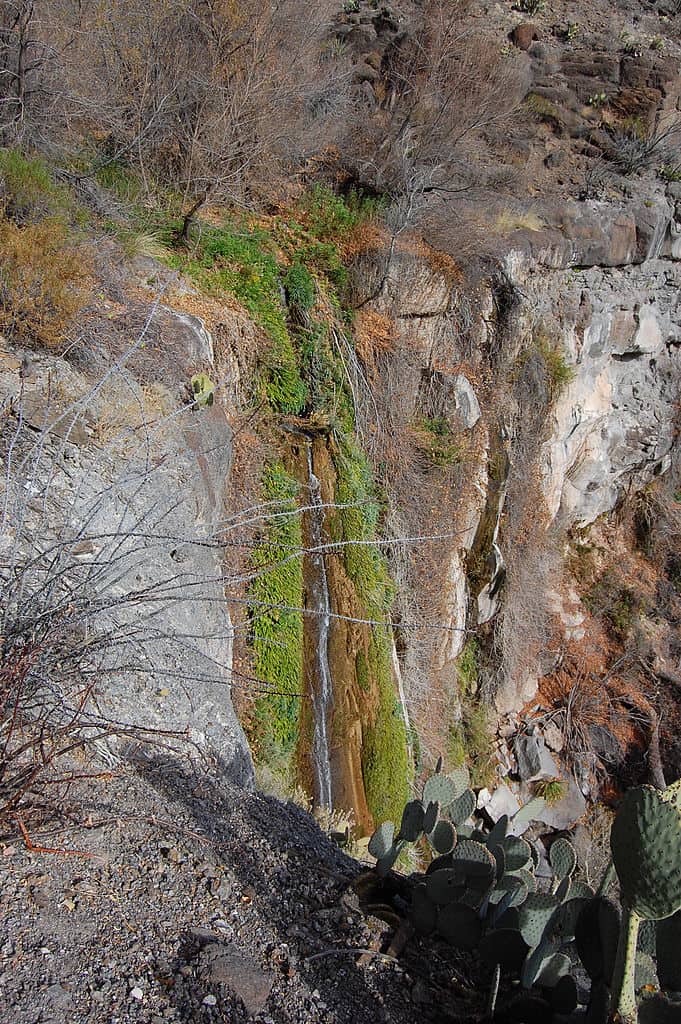
At 100 feet, Madrid Falls is both the tallest publicly accessible waterfall and the second-tallest waterfall in Texas.
©Freakinout / Creative Commons – License
Public Waterfalls in Texas
Capote Falls is the tallest waterfall in Texas, but as it’s on private land, spending the day admiring its view isn’t possible without permission from the landowner. However, if you want to spend time around Texas’s beautiful cascades, here are some waterfalls that are open to the public.
Gorman Falls: Colorado Bend State Park
Gorman Falls is a 65-foot-tall waterfall and possibly the most beautiful waterfall in Texas. One mile above the waterfall lies the spring that feeds the fall. It’s worth hiking here to see how nature fits together.

Gorman Falls is the most beautiful waterfall in Texas.
©JB Manning/Shutterstock.com
Airfields Falls: Fort Worth
Hike up the White Settlement trailhead to Carswell for six miles, and the eight-foot-tiered falls appear. It’s a beautiful trail that doesn’t require a 4×4 or Ironman level of scrambling.
Blue Hole Park: Georgetown
Possibly the most popular swimming spot in Texas is Georgetown. It has a short but narrow river-wide cascade. This pretty spot is part of the San Gabriel River, and many people love it, so get there early for the best picnic spot.
Boykin Springs: Angelina National Forest
This is a small 4-10 feet tall tiered waterfall near a picnic shelter and excellent camping sites. Follow the Sawmill Hiking rail to find the waterfalls.
Cattail Falls: Chisos Mountains, Big Bend National Park
It’s a three-mile hike to this 80-foot-tall waterfall, but it’s quiet and perfect if you want to escape the crowds. Ask for directions because it’s unmarked, and keep an eye out for black bears.
Hamilton Pool: Dripping Springs, Austin
This pool has a 50-foot waterfall and a limestone grotto behind the falls. The green pool is deep enough to swim in. It’s popular in summer, so arrive early!
Tallest Waterfall in the United States
The United States is full of tall waterfalls, but the very tallest is Olo’upena Falls in Hawaii. This incredible waterfall is 2,953 feet (900 meters) tall. It tumbles down the northeastern side of Molokai in Maui County on one of the world’s tallest sea-facing cliffs. It’s so huge it can only be seen entirely by air or ocean. This mega waterfall is the fourth tallest in the world.
Hawaii is home to the top three tallest waterfalls in the U.S.
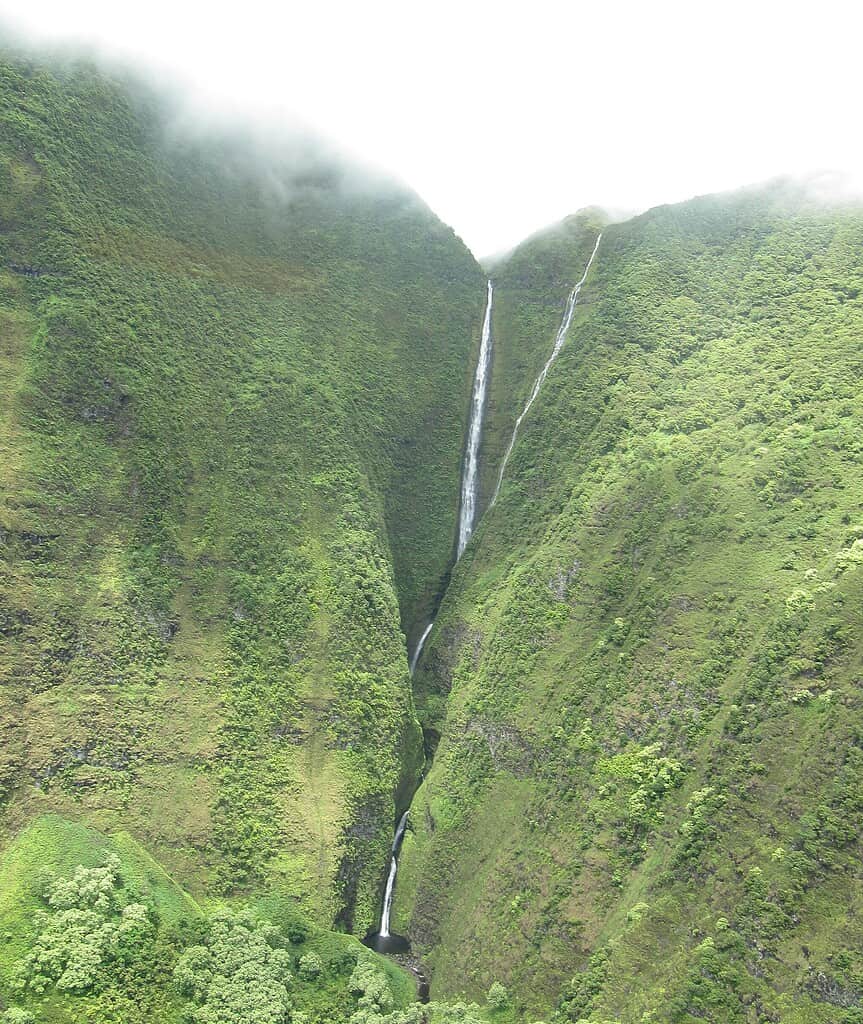
Oloʻupena Falls in Hawaii is the tallest waterfall in the U.S.
©Jay, CC BY-SA 3.0 – License
Tallest Waterfall in the World
Most experts agree that the tallest waterfall in the world is Angel Falls, in a remote Venezuelan rainforest. Water from the Gauja River falls an incredible 3,212 feet (979 meters) into a pool, but the fall is so long that not all water hits the bottom. Some of it is turned into mist by air pressure before it completes the fall. However, because it was measured in 1949, some people dispute the measurement.

The tallest waterfall in the world is thought to be Angel Falls in Venezuela.
©Claudio Soldi/Shutterstock.com
The second-highest waterfall in the world (some experts argue it’s actually the tallest) is Tugela Falls in Kwazulu Natal, South Africa. This waterfall is a series of tiered waterfalls that measure 3110 feet (948 meters) tall.
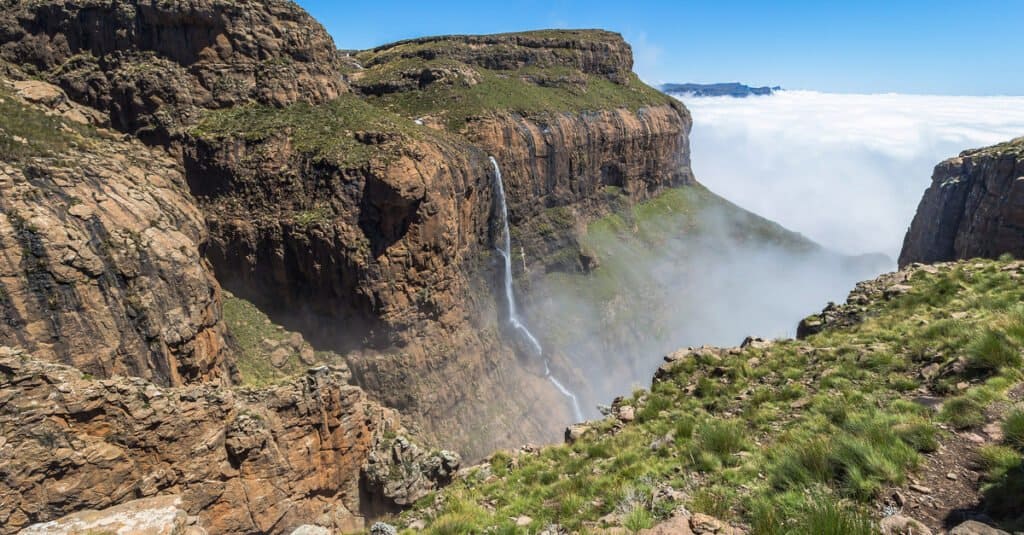
Tugela Falls in Kwazulu Natal, South Africa, can be considered the second-largest waterfall in the world.
©Robin Runck/Shutterstock.com
The photo featured at the top of this post is © Janece Flippo/Shutterstock.com
Thank you for reading! Have some feedback for us? Contact the AZ Animals editorial team.



